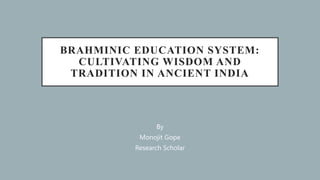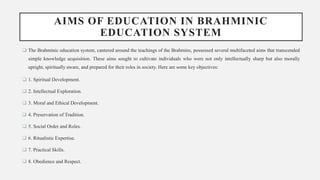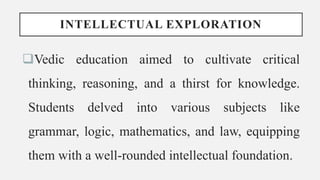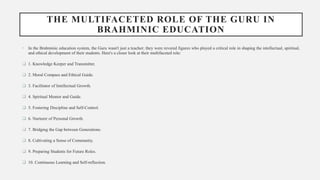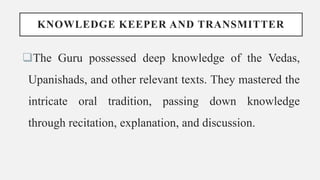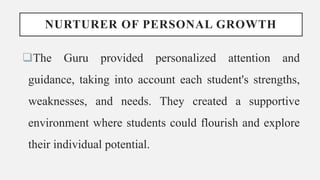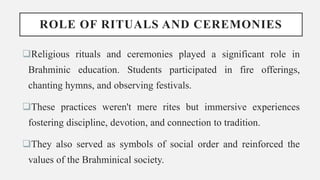Brahminic Education System.pptx
- 1. BRAHMINIC EDUCATION SYSTEM: CULTIVATING WISDOM AND TRADITION IN ANCIENT INDIA By Monojit Gope Research Scholar
- 2. INTRODUCTION The Brahminic education system flourished in ancient India from around 800 BCE to 500 CE. This system, cantered around the teachings of the Brahmins, emphasized religious and philosophical knowledge. The system aimed to instill values like piety, discipline, and obedience to social order.
- 3. EVOLUTION OF THE SYSTEM The Brahminic education system wasn't static but evolved over time. From around 800 to 500 BCE, Vedic learning remained dominant, focused on memorizing and chanting hymns. Later, as philosophical discussions gained prominence, the Upanishads emerged as central texts, leading to increased emphasis on intellectual engagement and debate. Gupta period (320-550 CE), education diversified, incorporating subjects like grammar, mathematics, and medicine. Universities like Nalanda and Takshashila became renowned centers of knowledge.
- 4. CORE VALUES Dharma: Emphasis on fulfilling one's duty and adherence to cosmic order. Karma: Belief in the cycle of cause and effect, shaping future lives based on current actions. Brahman: Understanding the ultimate reality, the universal, impersonal Brahman. Moksha: The ultimate goal of achieving liberation from the cycle of rebirth.
- 5. CURRICULUM AND TEACHING METHODS Vedas: The core texts, comprising hymns, rituals, and philosophical teachings. Upanishads: Philosophical treatises exploring topics like Brahman, Atman (soul), and self-realization. Smritis: Law books and social codes detailing religious observances and societal norms. Teaching methods: Oral recitation, memorization, discussions, debates, and practical demonstration of rituals.
- 6. LIFE IN A GURUKUL Residential schools led by Gurus (teachers), often located in serene natural settings. Simple lifestyles with minimal possessions, fostering discipline and austerity. Daily routines included morning prayers, studies, manual labor, and community service. Strict adherence to caste hierarchy, with Brahmin boys receiving the highest level of education.
- 7. GURUKUL: BEYOND THE CLASSROOM Gurukuls weren't merely academic institutions but holistic communities fostering personal growth. Daily routines included yoga, meditation, and manual labor alongside studies. Students learned practical skills like farming, cooking, and crafts, promoting self-reliance and responsibility. Gurukuls also served as cultural centers, with storytelling, music, and drama enriching the educational experience.
- 8. AIMS OF EDUCATION IN BRAHMINIC EDUCATION SYSTEM The Brahminic education system, cantered around the teachings of the Brahmins, possessed several multifaceted aims that transcended simple knowledge acquisition. These aims sought to cultivate individuals who were not only intellectually sharp but also morally upright, spiritually aware, and prepared for their roles in society. Here are some key objectives: 1. Spiritual Development. 2. Intellectual Exploration. 3. Moral and Ethical Development. 4. Preservation of Tradition. 5. Social Order and Roles. 6. Ritualistic Expertise. 7. Practical Skills. 8. Obedience and Respect.
- 9. SPIRITUAL DEVELOPMENT The paramount aim was to guide students towards self- realization and liberation from the cycle of rebirth (Moksha). This involved deep study of the Vedas and Upanishads, spiritual practices like meditation and chanting, and adherence to ethical principles.
- 10. INTELLECTUAL EXPLORATION Vedic education aimed to cultivate critical thinking, reasoning, and a thirst for knowledge. Students delved into various subjects like grammar, logic, mathematics, and law, equipping them with a well-rounded intellectual foundation.
- 11. MORAL AND ETHICAL DEVELOPMENT Character building was crucial. Students were instilled with values like honesty, self-control, respect for elders and teachers, and adherence to Dharma (righteous duty). This aimed to shape them into morally upright individuals who contributed positively to society.
- 12. PRESERVATION OF TRADITION The system aimed to preserve and transmit the rich cultural heritage of ancient India. Rigorous memorization and oral recitation ensured the continuity of Vedic knowledge, rituals, and customs across generations.
- 13. SOCIAL ORDER AND ROLES Education played a role in reinforcing the existing social order. Kshatriyas (warriors) received training in warfare, while Vaishyas (merchants) learned accounting and trade. This aimed to prepare individuals for their specific roles in society.
- 14. RITUALISTIC EXPERTISE Brahminic education equipped students with the knowledge and skills necessary to perform complex rituals and ceremonies. This was crucial for maintaining the social and religious order.
- 15. PRACTICAL SKILLS While the focus was primarily on religious and intellectual knowledge, some practical skills were also taught. Students learned activities like farming, carpentry, and household management, ensuring self- sufficiency and contribution to the community.
- 16. OBEDIENCE AND RESPECT The system emphasized obedience to elders, teachers, and the established social order. This fostered discipline, stability, and adherence to cultural norms.
- 17. THE MULTIFACETED ROLE OF THE GURU IN BRAHMINIC EDUCATION • In the Brahminic education system, the Guru wasn't just a teacher; they were revered figures who played a critical role in shaping the intellectual, spiritual, and ethical development of their students. Here's a closer look at their multifaceted role: 1. Knowledge Keeper and Transmitter. 2. Moral Compass and Ethical Guide. 3. Facilitator of Intellectual Growth. 4. Spiritual Mentor and Guide. 5. Fostering Discipline and Self-Control. 6. Nurturer of Personal Growth. 7. Bridging the Gap between Generations. 8. Cultivating a Sense of Community. 9. Preparing Students for Future Roles. 10. Continuous Learning and Self-reflection.
- 18. KNOWLEDGE KEEPER AND TRANSMITTER The Guru possessed deep knowledge of the Vedas, Upanishads, and other relevant texts. They mastered the intricate oral tradition, passing down knowledge through recitation, explanation, and discussion.
- 19. MORAL COMPASS AND ETHICAL GUIDE The Guru embodied the ideals of the Brahminical society, including piety, self-control, and adherence to Dharma. They served as role models, instilling these values in their students through daily interactions and teachings.
- 20. FACILITATOR OF INTELLECTUAL GROWTH The Guru didn't merely transmit knowledge; they encouraged critical thinking and intellectual inquiry. They facilitated debates, posed challenging questions, and helped students develop their own interpretations of complex concepts.
- 21. SPIRITUAL MENTOR AND GUIDE The Guru guided students on their spiritual journeys. They introduced them to practices like meditation, chanting, and rituals, helping them understand the ultimate goal of Moksha (liberation).
- 22. FOSTERING DISCIPLINE AND SELF-CONTROL The Gurukul's strict routines and austere lifestyle demanded discipline and self-control. The Guru ensured students upheld these expectations, shaping them into individuals capable of managing their thoughts and actions.
- 23. NURTURER OF PERSONAL GROWTH The Guru provided personalized attention and guidance, taking into account each student's strengths, weaknesses, and needs. They created a supportive environment where students could flourish and explore their individual potential.
- 24. BRIDGING THE GAP BETWEEN GENERATIONS The Guru served as a link between the rich cultural heritage of ancient India and the next generation. They ensured the preservation and transmission of traditional knowledge, customs, and values.
- 25. CULTIVATING A SENSE OF COMMUNITY The Gurukul functioned as a close-knit community. The Guru fostered a sense of belonging and brotherhood among students, promoting cooperation, respect, and service to others.
- 26. PREPARING STUDENTS FOR FUTURE ROLES Brahminic education not only focused on spiritual and intellectual development but also equipped students with practical skills like writing, accounting, and even warfare (for Kshatriyas). The Guru ensured they were well-prepared for their future roles in society.
- 27. CONTINUOUS LEARNING AND SELF-REFLECTION The Guru's role wasn't limited to teaching; they were also lifelong learners. They encouraged open discussions, welcomed challenges to their own knowledge, and continuously engaged in self-reflection to deepen their understanding of the world and the divine.
- 28. ROLE OF RITUALS AND CEREMONIES Religious rituals and ceremonies played a significant role in Brahminic education. Students participated in fire offerings, chanting hymns, and observing festivals. These practices weren't mere rites but immersive experiences fostering discipline, devotion, and connection to tradition. They also served as symbols of social order and reinforced the values of the Brahminical society.
- 29. WOMEN'S EDUCATION: A COMPLEX ISSUE While Brahminic education primarily catered to upper-caste boys, some avenues existed for women. Daughters of elite families received instruction in household management, religious teachings, and even certain arts and crafts. Some exceptions like Gargi Vachaknavi, a renowned philosopher, showcased the intellectual potential of women. However, the system largely excluded women from mainstream education, reflecting the prevailing societal norms.
- 30. STRENGTHS AND ACHIEVEMENTS Produced great scholars, philosophers, and spiritual leaders who shaped Indian culture. Emphasis on values like self-discipline, critical thinking, and social responsibility. Preservation of Vedic knowledge and traditions through meticulous memorization and oral transmission.
- 31. LIMITATIONS AND CRITICISMS Restricted access to education for lower castes and women, perpetuating social inequalities. Focus on religious and philosophical knowledge at the expense of practical and scientific skills. Rigid adherence to caste and social norms, limiting individual freedom and social mobility.
- 32. LEGACY AND MODERN RELEVANCE The Brahminic education system shaped Indian education for centuries and continues to influence traditional schools. The emphasis on values like discipline, respect for knowledge, and community service holds relevance even today. The system's limitations highlight the need for inclusivity and a balance between traditional and modern educational approaches.
- 33. PARA VIDYA AND APARA VIDYA • Para Vidya and Apara Vidya are two Sanskrit terms that are often used to distinguish between two different types of knowledge. Para Vidya is often translated as "higher knowledge" or "transcendental knowledge." It is the knowledge of the ultimate reality, Brahman, and the individual soul, Atman. It is the knowledge that leads to liberation from the cycle of rebirth. Apara Vidya is often translated as "lower knowledge" or "mundane knowledge." It is the knowledge of the world, including its physical and social aspects. It is the knowledge that is necessary for living in the world and fulfilling one's duties.
- 34. CONCLUSION The Brahminic education system offers valuable insights into ancient Indian wisdom and its approach to knowledge transmission. Acknowledging its strengths and limitations, we can strive to create inclusive and holistic educational systems for the future.
- 35. THANK YOU

